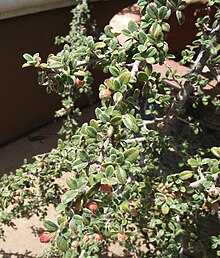
Cotoneaster is a genus of flowering plants in the rose family, Rosaceae, native to the Palaearctic region, with a strong concentration of diversity in the genus in the mountains of southwestern China and the Himalayas. They are related to hawthorns (Crataegus), firethorns (Pyracantha), photinias (Photinia), and rowans (Sorbus).

Acer circinatum, the vine maple, is a species of maple native to western North America, from southwest British Columbia to northern California, usually within 300 kilometres (190 mi) of the Pacific Ocean coast, found along the Columbia Gorge and Coastal Forest. It belongs to the Palmatum group of maple trees native to East Asia with its closest relatives being the Acer japonicum and Acer pseudosieboldianum. It can be difficult to distinguish from these species in cultivation. It is the only member of the Palmatum group that resides outside of Asia.

Cotoneaster franchetii is a species of Cotoneaster native to southwestern China, in the provinces of Guizhou, Sichuan, Tibet, and Yunnan, and also in adjacent northern Myanmar and northern Thailand.

Acer sieboldianum is a species of maple native to Japan and common in the forests of Hokkaidō, Honshū, Shikoku and Kyūshū Islands; in the south of the range it is restricted to mountain forests. It is named after Philipp Franz von Siebold.
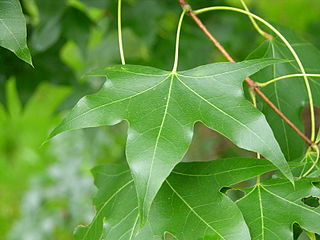
Acer truncatum, the Shantung maple, Shandong maple, or purpleblow maple, is a maple native to northern China, in the provinces of Gansu, Hebei, Henan, Jiangsu, Jilin, Liaoning, Inner Mongolia, Shaanxi, Shandong, Shanxi, and to Korea.
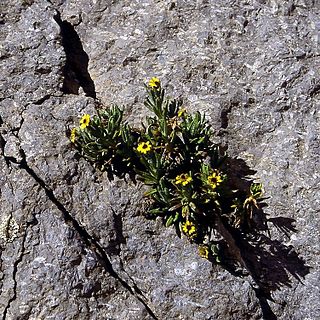
Atop of Mount Kenya Senecio keniophytum is one of the endemic groundsel (Senecio) found at high altitudes in Kenya, such as the Afro-alpine zone of Mount Kenya, but not one of the giant Dendrosenecio that also live there.

Cotoneaster cambricus is a species of Cotoneaster endemic to the Great Orme peninsula in north Wales. It is the only species of Cotoneaster native to the British Isles. It has never been found naturally at any other location. In the past, it was included within the widespread eastern European Cotoneaster integerrimus, but differs from that in genetic profile.

Cotoneaster integerrimus, the common cotoneaster, is a species of Cotoneaster native to central and eastern Europe and southwest Asia, from southern Belgium and eastern France south to Italy, and east through Germany to the Balkans, northern Turkey, the Crimea, the Caucasus and northern Iran; plants in Spain may also belong in this species. In the past, it was treated in a wider sense, including plants from Wales now split off as Cotoneaster cambricus and plants from Scandinavia now treated as Cotoneaster scandinavicus, but differs from these in genetic profile and detail of foliage and fruit.
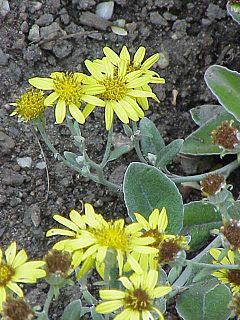
Brachyglottis greyi, commonly known as daisy bush, is a member of the large family Asteraceae and belongs to the genus Brachyglottis or the genus Senecio depending on which authority is being followed, an endemic native of New Zealand and lately getting positive attention from gardeners.

Beaufortia sparsa, commonly known as the swamp bottlebrush, is a plant in the myrtle family, Myrtaceae and is endemic to the south-west of Western Australia. It is an erect or spreading shrub with round, dished leaves crowded on the younger stems, and bright red flower spikes in the warmer months.

Olearia macrodonta is a small sub-alpine evergreen tree endemic to New Zealand, from the plant family Asteraceae. It is closely related to the narrow-leaved Olearia ilicifolia, with which it shares several characteristics including largely undulating and serrated grey-green leaves. These common characteristics mean the two species are often confused with one another. It is found in lowland to sub-alpine forests from the East Cape of the North Island of New Zealand southwards throughout the South Island and Stewart Island, at 450–1,200 metres (1,480–3,940 ft) in altitude.
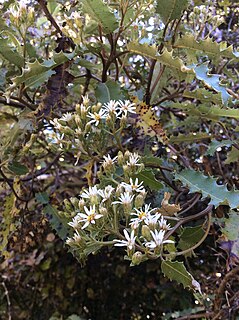
Olearia ilicifolia is a shrub or small tree endemic to New Zealand. Common names include Maori-holly, mountain holly, hakeke or hakekeke and New Zealand holly. It is a spreading shrub or small tree of the family Asteraceae, and has largely serrated and undulating grey-green leaves. It is closely related to the sub-alpine Olearia macrodonta, with which it shares the names mountain holly and New Zealand holly, however it is much more common than Olearia macrodonta. It is found in lowland and sub-alpine forests from sea level to 1,200 metres (3,900 ft).

Dracophyllum secundum is a prostrate to semi-erect shrub found in eastern Australia. It occurs from as far south as Pigeon House Mountain north to Kendall, New South Wales on the mid north coast. A common plant in the Blue Mountains near Sydney. Found as far west as Blackheath. It is often noticed by bushwalkers for the attractive flowers and arching foliage. The specific epithet secundum means "arranged on one side only".
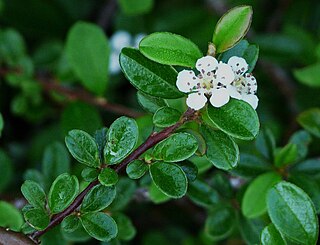
Cotoneaster dammeri, the bearberry cotoneaster, is a species of flowering plant in the genus Cotoneaster, belonging to the family Rosaceae, native to central and southern China and naturalized in Europe.

Elaeagnus pungens is a species of flowering plant in the family Elaeagnaceae, known by the common names thorny olive, spiny oleaster and silverthorn; also by the family name "oleaster". It is native to Asia, including China and Japan. It is present in the southeastern United States as an introduced species, a common landscaping and ornamental plant, and sometimes an invasive species.
Cotoneaster kweitschoviensis is a species of flowering plant in the family Rosaceae.
Cotoneaster kaschkarovii is a species of flowering plant in the family Rosaceae that can be found in Kangding and Sichuan provinces of China, and in Tibet.
Quercus baloot, the holm oak or holly oak is a rare species of oak that was described by Griffith in 1848. It is native to the Himalayas from 1,000–3,000 metres (3,300–9,800 ft).

Hakea constablei is a shrub in the Proteacea family native to eastern Australia. A bushy shrub or small tree with a profusion of white or cream flowers in spring.

Felicia fruticosa is a strongly branching shrub of up to 1.3 metres high that is assigned to the daisy family with flower heads consisting of about twenty purple to white ray florets encircling many yellow disc florets, and small flat, entire and hairless leathery leaves. Two subspecies are recognized. Felicia fruticosa subsp. brevipedunculata, from the Limpopo Province of South Africa is up to 1.3 metres tall and has longer leaves of 2.5 centimetres (0.98 in) long and 2 millimetres (0.079 in) wide and nearly seated pale violet to white flower heads. Felicia fruticosa subsp. fruticosa, from the Western Cape province of South Africa, is no more than 1 m and has shorter leaves of 1.25 centimetres (0.49 in) long and 2.5 millimetres (0.098 in) wide with flower heads on largely leafless, about 2.5 centimetres (0.98 in) long stems. It is sometimes called bosastertjie in Afrikaans. In the wild, flower occurs from August till October.
